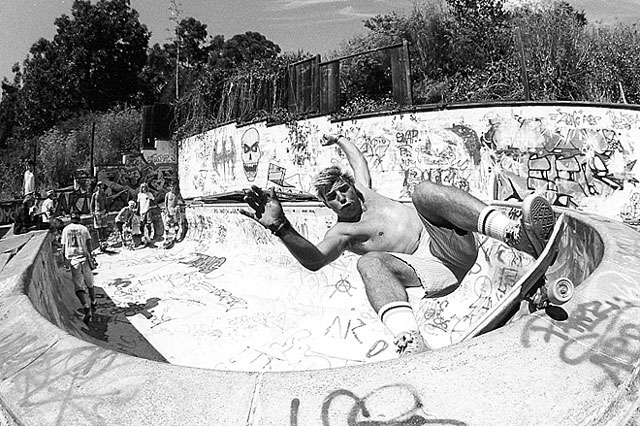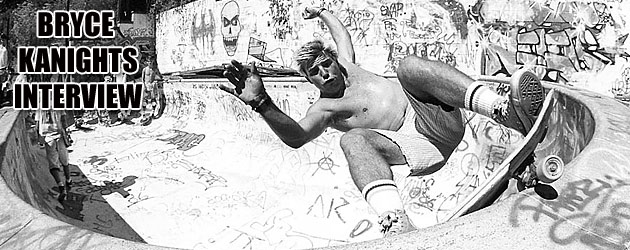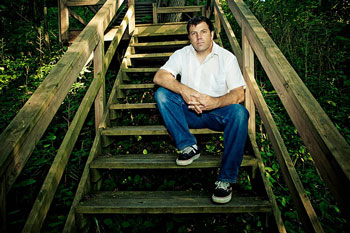 Bryce Kanights not only has one of the most memorable names in the history of the entire world, but he has also captured some of the most memorable moments in skateboarding’s history. Anyone who has rolled on board will have felt his vibes, because despite its length being comparatively brief with most pasttimes, the history of skateboarding has had Bryce’s input throughout.
Bryce Kanights not only has one of the most memorable names in the history of the entire world, but he has also captured some of the most memorable moments in skateboarding’s history. Anyone who has rolled on board will have felt his vibes, because despite its length being comparatively brief with most pasttimes, the history of skateboarding has had Bryce’s input throughout.
Hailing from San Francisco, Kanights captured cultural movements of all kinds as they shook not just the naturally shakey West Coast but the entire world. And as technology grew, so did the legend of the photos he had taken. Gonz skating Alcatraz in a prisoner’s outfit? Chris Senn flying through San Fran? The Chief’s barefoot ollie over the Gonz gap at EMB? All are photos that have in their own way helped shape the very big stamp San Francisco has made on skate culture.
In his time shooting Bryce has contributed and worked for the likes of Adidas, ESPN, EA Sports, Fuel, Konami, Nike, Oakley, Volcom, Kingpin Mag, Skateboarder Mag, Thrasher Mag, TWS Mag and more. Currently, he’s doing his part to keep the world updated on Skate Daily while still regularly laying on dirty floors and pushing a viewfinder into his eyes to document skateboarding in the way only he can. We caught up with him to get the full scoop on his own personal history, who he shot, what he shot with, who he shot for and what he listened to while doing it all.
Where you at right now Bryce?
I’m on a completely packed airplane flying across America on my way to New York City. Just took off out of Denver, three and a half hours of no frills air travel with barely enough room to move.
Look around you and name three random things you see…
Well, there’s the older guy seated next to me in the middle seat, he’s passed out with his reading glasses on and his book folded open in his lap, outside of my window there are over a dozen crop circles spread across the ground: the heartland of America. And this laptop computer with approximately 45% of the power remaining on its battery has a bit of a job to do while remaining confined in this situation.
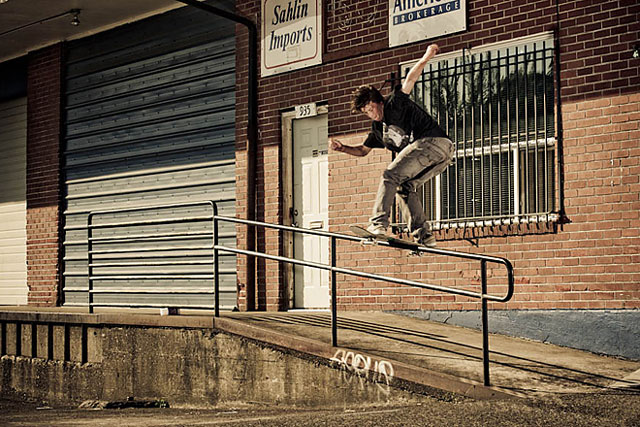
Aaron Daily – Frontboard
How long have you been a photographer?
I got into photography and began to shoot photos when I was a kid, but I didn’t really step it up until 1980 or so. I’d say I’ve spent just under 30 years of my life sitting, standing and laying in gutters on the streets while behind the lens.
What is the best and worst advice anyone gave you in regards to photography?
Well, the best advice was to look through the camera’s viewfinder to compose my photographs and to understand the rule of thirds. The worst advice was from my own teenage brain when the punk rock movement first hit San Francisco in the late 70s and early 80s. I was too caught up in the punk rock scene I guess to bother to carry around my camera to document the emergence of the Dead Kennedys, Black Flag, The Lewd, DOA, The Adolescents and many, many other bands that rolled through town at the time. Those historic and monumental moments during my days of youth were priceless.
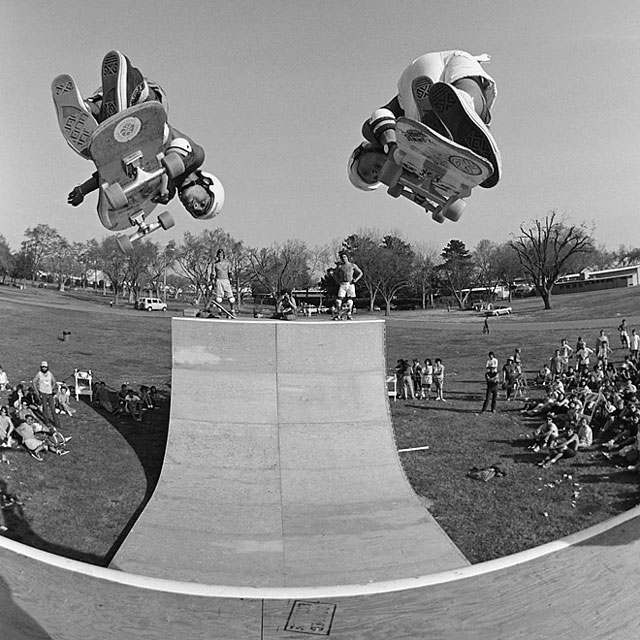
Cab and Hosoi – Dual Rockets (1986)
What artists have shaped you over the years and what music can you not leave for a tour without?
Music has always been a big part of my life and it inspires a great deal of what I do. At an early age I grew up with the Beatles, The Doors, Bob Dylan and Otis Redding playing on the stereo at home. Then as a teen, my friends and I would go to house parties and dance to soul and funk with The Jackson Five, Marvin Gaye, Brick, Stevie Wonder, Earth, Wind and Fire, James Brown, the Dazz Band and Parliament. Soon thereafter, through skateboarding, I discovered the power of rock through Van Valen, AC DC, Led Zeppelin, Kiss, and Thin Lizzy; then came along the late 70s and early 80s new wave and punk outfits like Devo, Joe Jackson, Bill Nelson’s Red Noise, Joy Division, XTC, Echo and The Bunnymen, The Buzzcocks, The Clash, Generation X, 999, Stiff Little Fingers, The Avengers, Toxic Reasons, The Ruts, Code of Honor, Los Olvidados, DOA, and so many, many more. On tour I’ve got to have various mixes to include reggae, jazz, 70s soul, 60s and 70s rock, 80s punk, 90s grunge, jazz and alternative artists as well.
That’s some classic shit right there, what’s the playlist for right now though in terms of favourites?
Some of my favorites today include, Radiohead, Miles Davis, Soundgarden, Deer Tick, The Clash, Sizzla, Editors, The Beatles, Gallows, Fugazi, The Jam, Tommy Guerrero, Three Inches of Blood, Pearl Jam, and Bad Brains.
Overall, music becomes a very influential and personal soundtrack to our individual lives. You can listen to a particular song and it can take you back to time where that song had a profound effect on you. Music is magical like that and I truly couldn’t live without it.
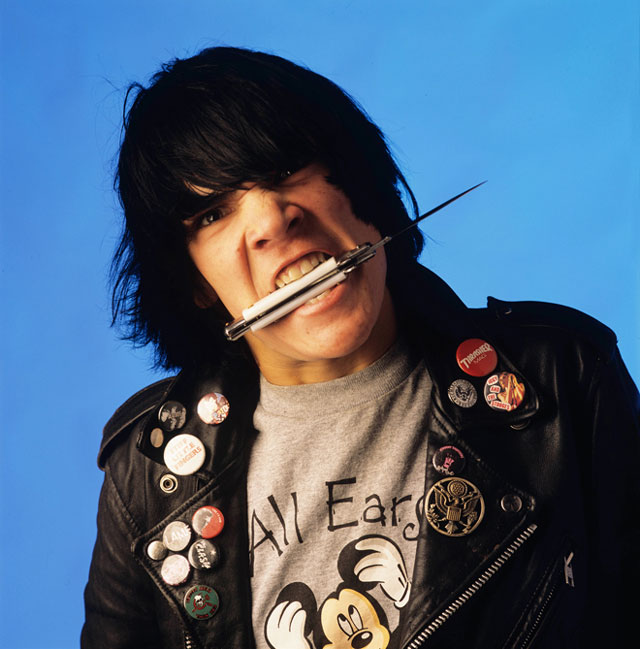
Corey Duffel
How many great bands have you met along the way that actually ripped on a skateboard though?
Well, back in the 80s, many of the so-called ‘skate rock’ bands held it down on four wheels. Brian Brannon of JFA rips, Dave Chavez of Code of Honor kills it on the bass and the skateboard, Germany’s Claus Grabke is equally talented on the guitar as he is on his skateboard, and last, but certainly not least, Pearl Jam co-founder and bassist, Jeff Ament tears on a skateboard. He has two concrete bowls on his property and has one of the most impressive skateboard collections that I personally know of. Despite his stardom as a rock and roll musician, Jeff is a tried and true skateboarder for life.
How did you get into skate photography?
I was 12 years old during the summer of 1975 when I first discovered skateboarding. Shortly afterward, I began to analyze the action images of Tony Alva, Jay Adams, Wally Inouye, Brad Bowman. Jerry Valdez, Eddie Elguera, Steve Alba, Rick Blackhart, Duane Peters, Steve Olson and other top pros printed in the pages of Skateboarder magazine.
With each successive month and every new issue that I purchased, I would read the magazine cover to cover and study and stare at the photos shot by their key staff photographers, James Cassimus, Craig Stecyk III, Warren Bolster and Ted Terrebonne. Their collective iconic images heavily influenced me; and drawing upon that groundswell of inspiration, I attempted to shoot action photos of my friends skating with a cheap Kodak instamatic camera. As you can imagine, it wasn’t a very suitable piece of equipment to capture action photos, but I tried anyhow. Nonetheless, I managed to capture a few worthwhile exposures and my interest in photography was sparked and continued to grow.
My father was a proficient photographer and as a gift for my 6th grade graduation that next summer, he provided me with a used, albeit very good, Nikon F 35mm SLR camera. From that point forward, I learned about shutter and film speeds, aperture, depth of field and more, and wherever my skateboarding would take me (and my friends), that camera would be along to document the sessions and good times.
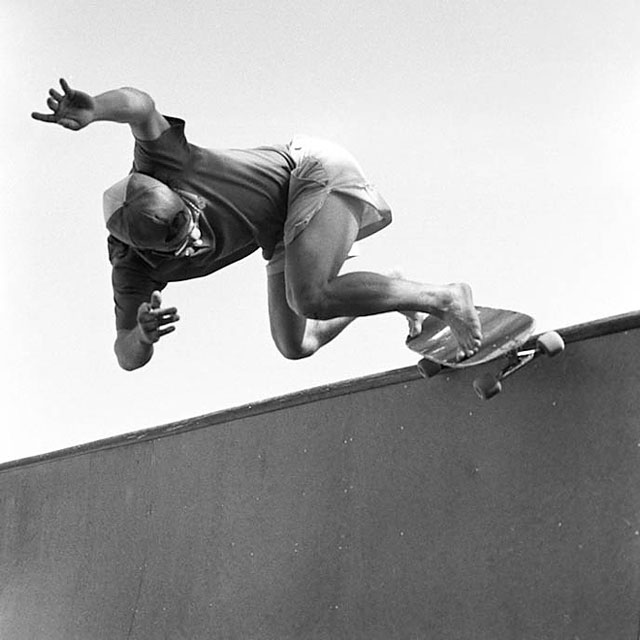
Joel Chavez – Tip-toeing Joe Lopes’ Backyard Ramp (1984)
Your skateboard knowledge and experience from these sessions bagged you a gig at Adidas a while back, what was your experience of working with a brand as big as this?
This subject is a tough one for me. Going into it after my hire with the company, I was quite stoked as I had skated in several adidas shoes as a youngster and I had a lot of respect for the brand with their heritage of producing great lines of footwear. I was brought on to recruit and build a talented team of riders for their renewed skateboarding program and to assist with the marketing efforts overall. Over the three years of time that I put in as Team Marketing Manager, I worked with some very great, talented people and delivered a respectable team and skate program. To this day, I’m very proud of the team of riders that I put together for adidas.
Unfortunately for me, the marketing genius that originally hired me, that I reported to, and with whom I was supposed to work with for the benefit of Adidas’ skateboarding effort, opted (along with his associates) to deliberately keep me out of the loop on several key marketing initiatives – including the skate team riders! Long story short, frustration grew, and sadly the trust and forward movement and opportunities within the skateboarding group began to collapse on several levels. It soon became apparent to me that the skate marketing group was locked in a climate of fear and mistrust, and my voice, my input, and years of experience in skateboarding was no longer of value.
Despite all that I did to build up the skate program and give it proper traction, my boss played a corporate card to throw me under the bus and keep his job and my contract was not renewed. Just a few weeks later, he was canned as well.
What was the worst era shooting skateboarding over the years?
Well, the worst days are thankfully behind us all. Imagine street skating’s progression during the early 90s when new tricks and possibilities were being landed at a very low percentage; truthfully, like one make out of every 50 or so attempts. And to shoot a photo sequence of say, a switch kickflip backside tailslide sometimes became a bit of a ridiculous experiment, and waste of film (and time). Unfortunately, this was several years before digital photography emerged. I recall burning through 20-30 rolls of film just to get certain groundbreaking tricks into the magazine. Eventually and thankfully, video capture software emerged and footage shot in Hi8 format was captured and made into sequences to be printed on the pages of the magazines. And as horrible as they looked, these crudely captured frames saved us (photographers) a lot of grief, money and time. This photographic nightmare paired with overly baggy trousers and small wheels, proved to be regarded as some of the darkest days in skateboarding’s relatively short history, but it was progression all the same.
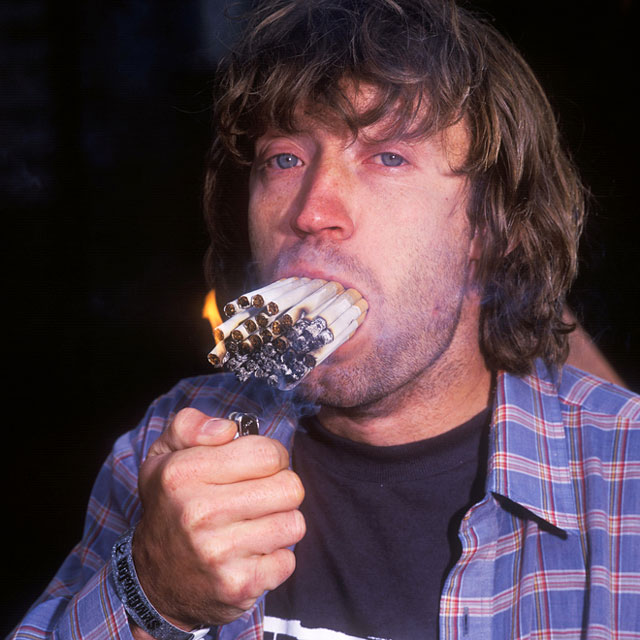
Dan Drehobl
Have you ever felt bad about taking a photo?
Yes, usually the images of my friends taking a gnarly slam are ones that hurt everyone involved.
You must have to deal with a lot of injuries on the road from people setting standards at the many spots that have world-renowned status, what is the most impressive trick you have shot to date that got away clean when you knew deep down that the skater fronting it could have seriously hurt himself?
Every single frame that I shoot of the Mega Ramp/Big Air event at the X Games each summer is truly exhilarating. I mean, if those guys miscalculate just a couple of inches, they can die! Look at what happened to Jake Brown in 2007. He narrowly escaped death. Seriously, those guys should be rewarded much, much more for the risk involved in that display of balls-out skateboarding.
Below: Chewy Cannon
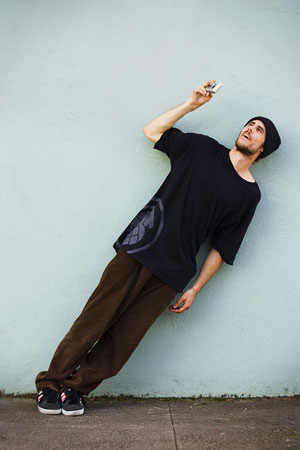 Is the younger generation more fearless?
Is the younger generation more fearless?
As a general rule, the younger you are the more fearless you will be. If you think about it, this opinion completely makes sense. Your bones are more flexible as a younger skater and repeatedly jumping down big sets of stairs, or bailing and running out from a lofty air above a transition doesn’t beat you up so much as a teenager. That soon begins to change when you reach your late 20s. Sure, the skate equipment is better from what we had as kids years ago, but all the same, the progression, benchmarked expectations, and the level of gnarliness has far surpassed any sense of real fear.
Thankfully, my generation learned to knee slide on transitions when we were teenagers, but then again, the jump ramp era of the 80s hammered our knees and destroyed our ankles years later. But we never jumped down huge flights of stairs, long railings or massive gaps repeatedly! While I ache with pains from time to time, I sometimes wonder just how much more physically damaged the current generation of skaters will be when they reach their forties. I feel it’s becoming a safe bet to invest in stock with artificial joint replacements in the coming years.
Which new ams are blowing your mind with their skateboarding right now?
Well, the number one young gun in my mind is Grant Taylor although he is no longer an amateur. He absolutely kills it on all terrain. The skaters that can slay a rail, destroy a ledge, kickflip a massive gap or drop, and take on all transitions are the ones that will rise up in the future. Ben Raybourn, Raven Tershy, Taylor Bingaman, Kevin Kowalski, Evan Smith, Curren Caples, Davis Torgerson, and Ben Hatchell. But then again, there are several street skaters that are absolutely amazing too! Cory Kennedy, Ishod Wair, Vincent Alvarez, Luis Tolentino, Felipe Gustavo, Clint Walker, Aaron Hamoki, Tony Karr, Mark Suicu all come to mind.
The internet plays a roll in pushing skateboarding forward at a faster rate than print magazines and DVDs could ever, how has the web changed the way you work in your profession as a photographer?
When I’m shooting in a public area such as a skatepark or in the streets, I tend to take notice of others on location with cameras. I’m more aware these days of other people willing to poach photos or video footage of the shoot that I’ve arranged. Once those images and video clips shot by others make it onto the web before yours do, it diminishes the published value for print media and commercial use. Fortunately, the poaching thing is not too common, but it does happen, so we tend to protect our shoots more.
Below: Gunes Ozdogan – Crooks
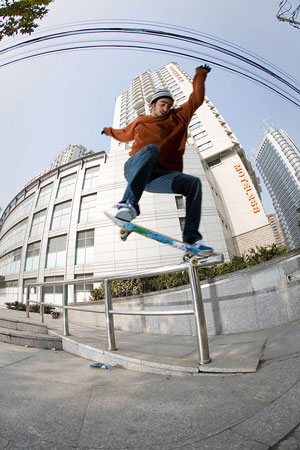 Do new forms of media and cheaper cameras breed more hungry skate photographers than ever before? What’s it like out there in the US in terms of people pushing photography to different levels?
Do new forms of media and cheaper cameras breed more hungry skate photographers than ever before? What’s it like out there in the US in terms of people pushing photography to different levels?
Well, with digital photography and digital media in general, just about anybody with the proper cameras and equipment, a connection to the web, and the gumption, can shoot and deliver visual content these days. The publishing paradigm has taken on a revolutionary shift and we’ve reached a point of oversaturation with the amount of digital content that is published on a regular basis. Blogs and websites churn out images and video content constantly. Add smart phones and mobile media to the mix, and everything, everywhere, at all times becomes digital and disposable content in an instant, for better or worse.
The ease of use with digital photo and video equipment has greatly improved the quality of images that we see from pros and amateurs alike. With software like Photoshop and Final Cut Pro the learning curve has opened up greatly for enthusiasts and has helped to push the progression at a faster rate. For aspiring skate photographers and videographers, the tools of the trade are much more user-friendly and can yield much more professional looking results quickly.
You have been running the www.SKATEDAILY.net website now for over 6 years which has grown into one of the best news feeds in the USA, how addictive does it actually become to feed your own desire to keep people in the know?
It’s not so much of an addiction as it is a regular means to share skateboarding-related info and content over a few minutes each day. I admit it’s a bit tough to juggle the workload between our regular day jobs and travel schedules, but we continue to carry on and update the site regularly.
How far can the site go, knowing that video online is becoming king?
Well, much has changed with digital media and online content in the past six years hasn’t it? We continue to strive to deliver our news and info as best possible with unbiased, factual reports without any political standpoint. We’re moving closer to delivering exclusive content with photo features, interviews and reports with video in the coming months.
Below: Dave Bachinsky – Frontside Flip
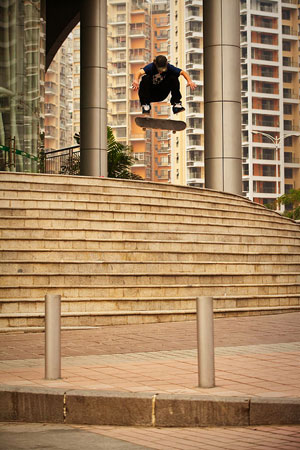 What’s the relationship like between a photographer and filmer?
What’s the relationship like between a photographer and filmer?
At times it’s a tough battle in regards to working with one another. I come from the old school of skate photography, several years before video parts were paramount and video clips were pumped out on the web every day. Today, you have to balance your craft and the desired look and feel of your images with the democratic process of asking the filmer to back out of your shot, etc. In all honesty, it’s a bit of give and take. I always prefer to pair up with filmer that opts to shoot creative angles and not to employ the fisheye angle for the entire session.
Are there ways of getting better/free equipment as you continue to grow or do you have to fund everything yourself?
As you grow in your field of work, opportunities arise and present themselves in very humbling and surprising ways. I’ve been fortunate to receive some free gear bags and a couple of cameras free of charge. As much as I enjoy new gear as the other guys, I usually purchase my gear at retail prices. I prefer to work with my regular and familiar kit of cameras, lenses and lighting so I don’t upgrade all that often. A sponsorship for this pricy stuff would be cool though. With that said, does anyone have a spare Hassleblad H4 that they’d like to part with? I’m game.
Is the work of a skate photographer well paid?
I’m certain that it pays better than that of a skate videographer, but it’s not a profession that is going to lead to an early retirement. Besides the photography end of the job, there is plenty of downtime and waiting, broken boards and equipment, security guards, cops, irate civilians, and long hours to it, but in the end it’s completely gratifying.
Would you recommend digital for beginners?
Absolutely. The ease of use, learning curve, instant results is much more favorable. Film has become a more specialized medium and it makes absolutely no economic or fundamental sense for a beginning photographer to learn from their mistakes through the regular use of film.
If you were to buy a pocket snapper for capturing skating on a budget to get going, which camera would you suggest?
Canon’s line of PowerShot “point and shoot” cameras including the G9, G10 and G11 models have always been great for the most part. Despite their inherent shutter delays, I’ve used both the G9 and SD 780IS models over the past several years and they’re very intuitive by design and produce great photos and video. But if you’re looking to capture the action with more precision, the step up to a proper DSLR is inevitable.
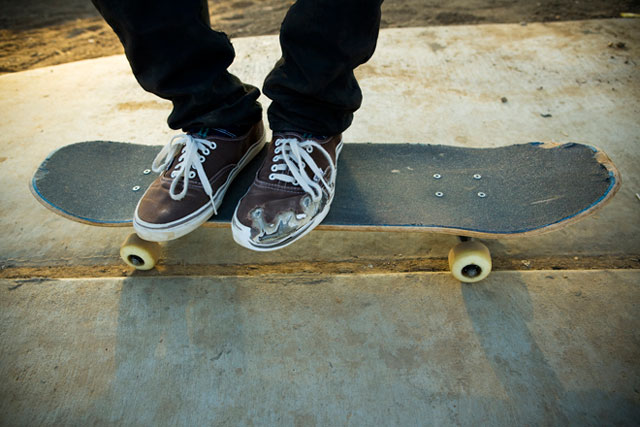
Skate Daily
What are the benefits of using digital?
For beginners, and amatuers and professionals shooting high-end commercial work, digital is definitely the more efficient way to go. The image sensors of today’s top end DLSRs and medium format digital backs now yield a wider range of tonality and latitude than that of film. I look at cameras as imaging tools for the most part, and all of them have their strengths and weaknesses. Depending on the job or desired look of a particular photo, the choice of camera becomes quite clear.
…and film?
The use of film definitely slows down the process of photography. And that can be a great thing! You shoot fewer shots than you would with digital capture and you take more time to think through your exposures. Film is becoming more of a medium for fine art and personal images. I still prefer the grain and aesthetic feel of black and white negative film. For color, digital images can easily match the look of traditional E6 and C41 development processes in post-production.
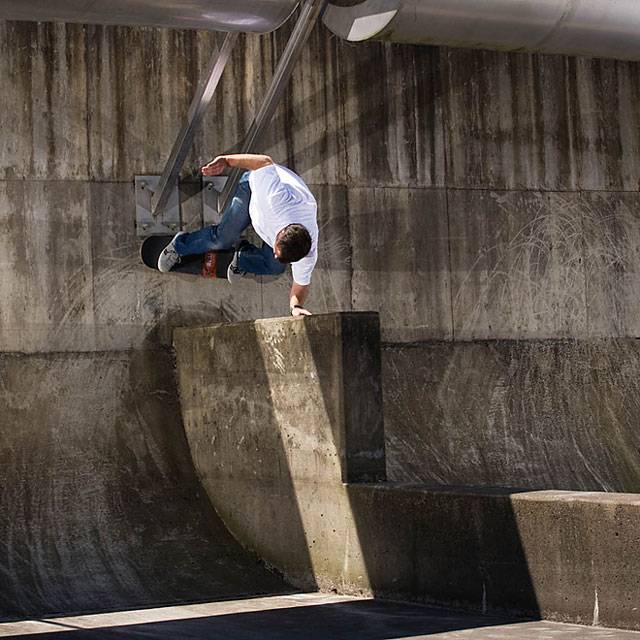
Bryce Kanights – Wallride
What kit do you use?
I’ve relied upon Canon equipment and lenses for the past 25 years. I currently shoot the majority of my 35mm photos digitally with EOS 1D Mark II and 1Ds Mark II DSLRs although I still enjoy the use of my Hasselblad X Pan II for panoramic photographs. For medium format and film photography I use a Hasselblad 503CW. For lighting I rely upon Pocket Wizard radio slaves for wireless triggering of my Quantum Q Flash, and Lumedyne strobes.
Overall, what main advice would you give to upcoming skate photographers?
Look through your lens, study the light, and absorb the experience, examples and teachings of others. Learn from your mistakes and follow your heart. Oh yeah, don’t reply on the auto exposure mode of your camera…and purchase a good light meter too!
Web links?
My photo site is www.brycekanights.com, my personal blog is www.nostalgianow.blogspot.com and my video blog is www.vimeo.com/user859346
